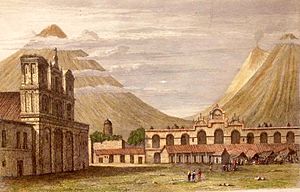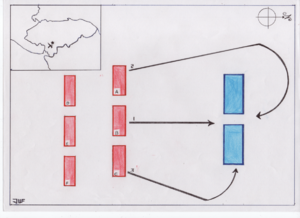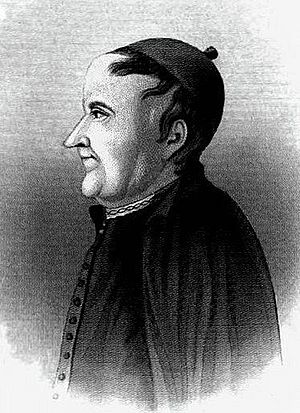First Central American Civil War facts for kids
Quick facts for kids First Central American Civil War |
|||||||
|---|---|---|---|---|---|---|---|
| Part of the Central American Civil Wars | |||||||
 The Battle of La Trinidad on a Honduran 5 lempira bill. |
|||||||
|
|||||||
| Belligerents | |||||||
|
|
|||||||
| Commanders and leaders | |||||||
|
|
||||||
| Strength | |||||||
| >2,000 | ~2,000 | ||||||
| Casualties and losses | |||||||
| Unknown | Unknown | ||||||
The First Central American Civil War was a big fight within the Federal Republic of Central America. It lasted from 1826 to 1829. This war was between two main groups: the Liberals and the Conservatives. Francisco Morazán led the Liberals. Manuel José Arce, who used to be a Liberal, led the Conservatives.
Contents
Why the War Started
Manuel José Arce became the first President of the Federal Republic of Central America in April 1825. On October 10, 1826, President Arce made a controversial move. He closed down the congress. He wanted a new congress to be elected that would support his conservative ideas. This decision went against the rules and upset the Liberals.
The leader of Honduras, Dionisio de Herrera, did not agree with Arce's actions. But President Arce said that Herrera's time as leader was over. Arce then decided to remove Herrera from power. He claimed he was protecting government tobacco farms.
The Civil War Begins
Fighting in Honduras
Dionisio de Herrera became the leader of Honduras in September 1824. His term was supposed to end in September 1827. However, President Manuel José Arce ordered José Justo Milla to overthrow Herrera in 1827.
On April 4, 1827, General Milla attacked the city of Comayagua with 200 men. General Francisco Morazán led the defense of the city. Milla's forces won the fight and burned down the capital. President Dionisio Herrera was captured on May 9 and sent to Guatemala. José Justo Milla took control of Comayagua.
General Morazán managed to escape with some officers. He went to Tegucigalpa and gathered 300 more men. He planned to return to Comayagua, but Milla's troops attacked him. Morazán fought back and defeated them. He then returned to Tegucigalpa to get even more support.
Later, Francisco Morazán went to Choluteca to meet his family. But he was captured by the commander of Tegucigalpa. He was released after 23 days. He then had to escape to El Salvador in July 1827. He later moved to León in Nicaragua. There, his friend General José Anacleto Ordóñez gave him 135 men. Salvadoran soldiers also joined him. Their goal was to take back Comayagua.
Battle of La Trinidad
In October 1827, Morazán entered Choluteca. Colonel José Antonio Márquez was waiting for him with more soldiers. The town of San Antonio of Texiguat also offered Morazán weapons and men.
General José Justo Milla found out Morazán was in southern Honduras. He quickly moved his troops to Tegucigalpa. Morazán went to Sabanagrande to prepare for a big fight in the Valle de la Trinidad.
On November 11, 1827, the battle began. Colonel Ramón Pacheco attacked Milla's forces. Colonel Remigio Díaz led 150 men to attack the enemy from behind. General Morazán, with Colonel Román Valladares, attacked the right side of Milla's army.
The fighting was intense and lasted for five hours. By 3:00 p.m., Milla's troops were defeated by Morazán's men. General José Justo Milla and some of his officers ran away. They left behind important documents and supplies. About forty soldiers were hurt or killed.
After this victory, Morazán marched to Tegucigalpa and took it back on November 12. On November 26, he entered the capital Comayagua in triumph. He took control of Honduras and appointed himself as the new leader.
War in El Salvador
After his win at La Trinidad, Morazán became known as a strong leader for the Liberal cause. He was seen as a skilled military commander across Central America. Liberals in El Salvador asked him for help. They were against the new conservative lawmakers that President Arce had put in power. Salvadorans wanted their old leaders back.
In March 1827, El Salvador's government sent its army towards Guatemala. They wanted to take the capital and remove Arce. But President Arce led his own troops and defeated the Salvadorans on March 23 at the Battle of Arrazola. Many Salvadoran soldiers were captured or ran away.
After this battle, President Arce sent 2,000 federal troops to occupy El Salvador. Meanwhile, Francisco Morazán prepared to help El Salvador. He stepped down as leader of Honduras and had Diego Vigil take his place. He went to Texiguat to organize his army for the fight in El Salvador.
In April 1828, Morazán entered El Salvador with 1,400 men. This group was called the Protective Allied Army of the Law. It included soldiers from Honduras, Nicaragua, and El Salvador. Some were volunteers who believed in the Liberal cause. Others hoped to earn something after the war.
While the Salvadoran army fought federal forces in San Salvador, Morazán fought in the eastern part of the state. On July 6, Morazán defeated Colonel Vicente Domínguez's troops.
Morazán continued to fight around San Miguel. He defeated every group of soldiers General Arzú sent from San Salvador. These defeats made Arzú leave Colonel Montúfar in charge of San Salvador. Arzú decided to deal with Morazán himself. When Morazán learned of Arzú's movements, he went to Honduras to get more troops.
Morazán soon returned to El Salvador with a larger army. General Arzú, who was sick, fled back to Guatemala. He left his troops with Lieutenant Colonel Antonio de Aycinena. Morazán's men stopped Aycinena's troops on October 9. Aycinena was forced to give up. With this surrender, El Salvador was finally free from federal troops.
On October 23, General Morazán entered San Salvador in victory. A few days later, he went to Ahuachapán. His goal was to organize his army to remove the conservative leaders in Guatemala. He wanted to bring back the proper rules to the Central American Federation.
March to Guatemala
In Ahuachapán, Morazán worked hard to build a large army. He asked El Salvador for 4,000 men, but he got 2,000. In early 1829, he sent Colonel Juan Prem to take control of Chiquimula in Guatemala. Prem succeeded despite enemy resistance.
Morazán then moved a small group of soldiers near Guatemala City. He wanted to draw the enemy out and make their soldiers leave. Colonel Vicente Domínguez left Guatemala City with 600 soldiers to attack Prem. But he heard about Morazán's small force and changed his plans. Prem took this chance to attack Domínguez's forces, defeating them on January 15, 1829. After this, Morazán ordered Prem to move his 1,400 men closer to the capital.

Meanwhile, people in Antigua Guatemala rose up against the conservative government in Guatemala. They asked General Morazán for protection. This made Morazán speed up his invasion of Guatemala. He placed his men near Guatemala City.
The fighting around the capital began with small clashes. On February 15, a large part of Morazán's army was defeated. Because of this, Morazán stopped his attack on the city and gathered his forces in Antigua. Federal troops followed him, planning to attack him in Antigua. But they spread out their forces too much. On March 6, Morazán defeated them, which boosted his army's spirits.
After this victory, more Guatemalan volunteers joined Morazán's army. On March 15, Morazán's army was on its way to its old positions. They were stopped by federal troops. Morazán's army, being stronger, crushed the enemy. The battlefield was covered with fallen soldiers. Morazán's allies captured many prisoners and weapons.
Morazán then moved back to his positions and started to attack Guatemala City again. The fighting continued with great success for Morazán's army.
To defend the city, the governor of Guatemala, Mariano de Aycinena y Piñol, made a harsh rule on March 18, 1829. Anyone helping the enemy would be put to death. He also declared several Liberal leaders as enemies of the state.
On April 12, the governor of Guatemala, Mariano de Aycinena y Piñol, surrendered. The next day, Morazán's troops took over the main square of Guatemala City.
What Happened Next
Right after Guatemala City surrendered on April 13, President Arce, Mariano Aycinena, and other officials involved in the war were put in prison. General Morazán then led Central America for three months. On June 26, 1829, Congress appointed Senator Juan Barrundia as President.
Morazán expelled Aycinena and other conservative leaders from Guatemala. He also removed many members of the Catholic Church who supported them. Not only did he send them away, but he also took all their property.
On June 4, 1829, Morazán's government passed a law. It said that all members of the Aycinena family who were part of the conservative government could face the death penalty. One of them, Antonio José de Irisarri, was captured. He was saved from being executed by a soldier. He was sent to San Salvador and imprisoned for nine months. Irisarri managed to escape on January 7, 1830, and fled to Ecuador.
See also
 In Spanish: Guerra civil centroamericana para niños
In Spanish: Guerra civil centroamericana para niños
- Federation of Central America
- Second Central American Civil War



